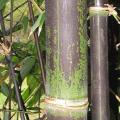 |
||||||||||||
|
|
||||||||||||
 |
||||||||||||
 |
|||||||
|
|
|||||||
|
|
|||||||
|
Black bamboo, like other black plants or flowers, fascinates people. We get endless enquiries about it; simply because it's black. And black bamboos are amongst the best sellers of them all. We must admit to sharing this fascination for black bamboo, especially for the clumping black bamboo species. However, black bamboo varieties are not necessarily the best performing bamboo plants in the landscape. The clumping black bamboos are not quite as cold hardy as some other non-invasive bamboos and may not look their best all year round in cooler areas, unless planted in warm sheltered sites. However their great beauty throughout most of the year and the value of their timber make them certainly worth growing. Many people are unaware of the superior landscaping bamboo species like Gracilis; they just want black bamboo. The common Running Black Bamboo (Phyllostachys nigra) is not a bad choice; except that it's invasive, can be badly damaged by bamboo mites and often has brown tips to the leaves caused by drying out too much, just once. On the other hand it's short, cold tolerant and it is a black bamboo. The pink shoots are small but sweet, and the timber is both useful and ornamental. This bamboo is still very popular, but bear in mind that it is invasive and that all Phyllostachys species have been declared noxious weeds in some areas. If you install suitable in-ground barriers (and cut back the rhizomes that will try to escape over the top in autumn) you can keep it contained. Timor Black Bamboo (Bambusa lako) is a medium size (12-16M) clumping black bamboo. Timor Black is very upright and tidy; an attractive plant with light green leaves and dark brown or black culms with lighter stripes. The culms are very glossy which makes them especially attractive. Though beautiful, this black bamboo is not very cold or wind tolerant, and is much better suited to warm sheltered sites. It becomes shabby here in winter, to recover every year and look good again in spring. Atro (or Javanese Black Bamboo) (Gigantochloa atroviolacea) is about the same size as Timor Black Bamboo but a little tougher. It is damaged by heavy frost, especially the late shoots. The early shoots develop well and are not damaged, but as with Timor Black Bamboo, the leaves yellow and look a bit shabby every winter. It is however, very black, and very ornamental with large leaves, and produces top quality black bamboo poles for timber. Dendrocalamus species are generally more cold hardy than Gigantochloa species. Black Asper Bamboo and Black Brandisii Bamboo are both more cold tolerant again than Atroviolacea. Black Asper Bamboo (Dendrocalamus asper var. Hitam) is always popular, and people who see all our black bamboo generally like this one best. It is beyond doubt one of the great bamboos, producing extraordinarily beautiful and valuable bamboo timber and highest quality, sweet, edible shoots. This black bamboo has reportedly becoming rare in it's native home (Java) because of over-harvesting. It grows very well here; almost as vigorous as Latiflores (our strongest growing bamboo species). New shoots and young culms are covered in soft velvet. White bands on green-striped black culms, and large leaves make it very beautiful. If you have lots of space it's a bamboo well worth growing and is one of the most beautiful of all plants not just black bamboos. Remember that it is a very big bamboo growing to 25 or 30 metres and needs plenty of room. Black Brandisii Bamboo (Dendrocalamus brandisii var. black) is from a Brandisii seedling grown here in Australia. We have two recognisable clones and they produce both black and very dark brown culms. In full sun (or on the sunny side of a clump) they are browner, sometimes mottled with orange or green. In shade they are blacker. The lower internodes retain the soft white hairs that are a characteristic of Brandisii Bamboo, and still look pale grey as the upper culms are turning black. Even large diameter shoots taper off fairly quickly, and grow to about 10 or 12 metres. This makes Black Brandisii Bamboo more suitable for smaller gardens. The shoots are delicious and the timber is very thick walled, almost solid at the lower internodes. Another bamboo we grow is called New Guinea Black Bamboo (Bambusa 'New Guinea Black'). Now known to us as "New Guinea Brown", this attractive small plant has culms that turn very dark green, and then almost black, and then to very dark brown when grown in the sun. Older shade grown plants are just green and not black at all. Plants grown in full sun seem to stay brown or develop culms with a more mottled appearance similar to Pring Tutul (Bambusa maculata) - the Turtle-shell Bamboo from Bali. Guadua 'peruana', is another bamboo that almost turns black and then becomes green. Also known as the 'almost thornless' Guadua, it is an attractive, hardy bamboo, with thick ovate leaves. Dinochloa scandens is a tropical climbing black bamboo. This pretty little plant with dark stems and unusual foliage grows very slowly here, and requires warm shady conditions. They are slow growing, react very badly to full sunlight, and do not like our cool dry winters and so will probably have limited use in southern Australia. It may have some potential as an indoor plant, but after performing badly for two winters we have decided not to grow any more. Top Home Contact Us
|
|||||||